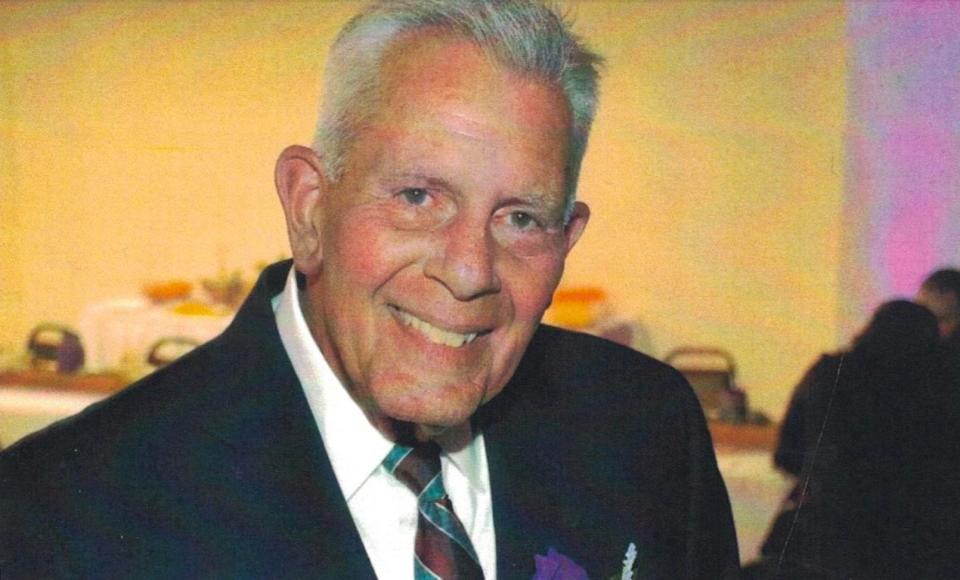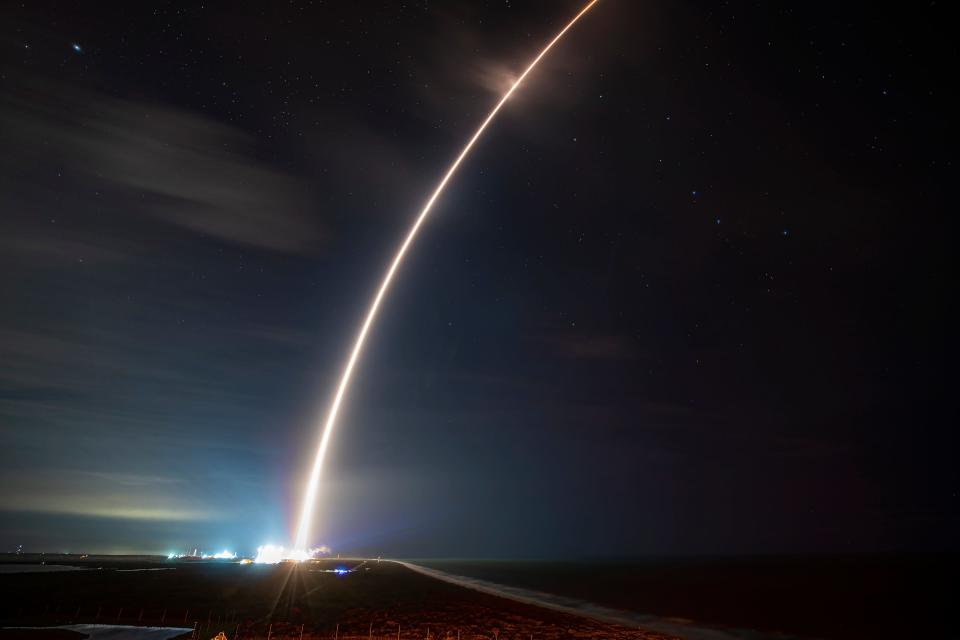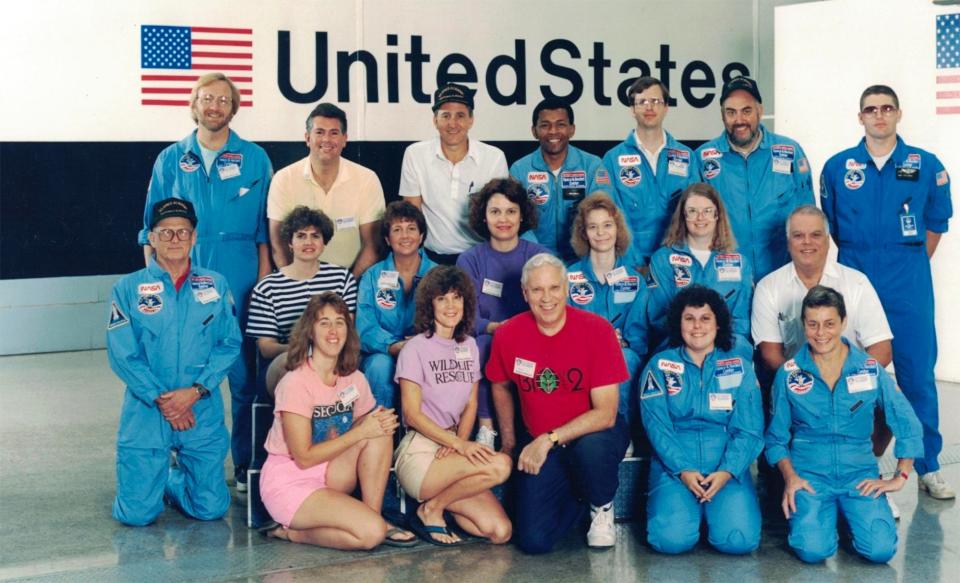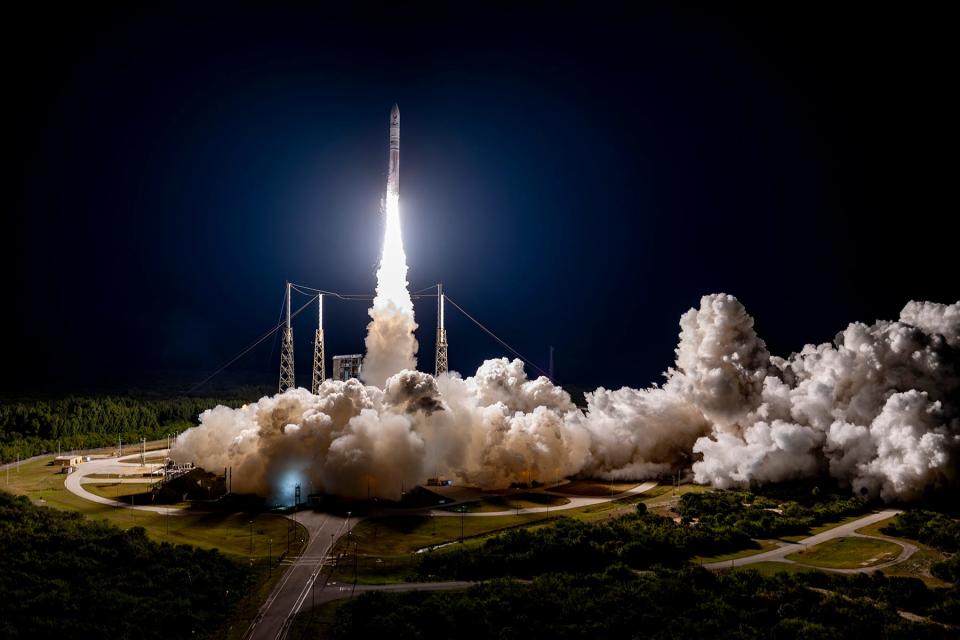York man's ashes blasted into space aboard the Enterprise - along with Star Trek crew
David Gardner came of age during the space race.
He was 4 years old in 1957 when the Soviet Union launched the space race with the satellite Sputnik. He was 8 years old when Alan Shepard became the first American to leave Earth’s atmosphere aboard the inaugural manned flight of the Mercury spacecraft. The following year, President John F. Kennedy, in a speech at Rice University in Houston, pledged that the United States would land a man on the moon by the decade’s end, a goal that was achieved on July 16, 1969.
He grew to love astronomy and space, the mysteries of the vastness of the universe sparking his sharp curiosity and imagination. He and his wife had a small telescope and spent untold hours gazing at the planets and the stars.

He often told his wife, Jean Patz Gardner, that he always wished he could have been an astronaut, one of the humans who were blessed with the good fortune of being able to leave Earth and explore the vast emptiness that lies beyond our atmosphere. “When we get $10 million, you can go to space,” Jean said.
That wish went unfulfilled when he died on June 12, 2020.
That was until early Monday morning.
Now, part of him will spend eternity in deep space.
David gets his wish
At 2:18 a.m. Jan. 8, Monday, David got his wish to go on a space flight. A Vulcan Centaur rocket – the largest spacecraft built by a company called United Launch Alliance – blasted off from Cape Canaveral. It was the inaugural launch of the rocket, designed to carry heavy payloads into orbit and beyond. (By coincidence, Jean’s brother Mark works for Moog Engineering near Buffalo, and he worked on components of the Vulcan Centaur.)

One stage of the rocket – called the Peregrine Lunar Lander – will detach and land on the lunar surface. Another capsule will continue into deep space, settling into a solar orbit between Earth and Mars, more than 185 million miles from Earth.
A vial of David’s ashes was among the 150 cremated remains and DNA samples aboard that capsule, named the Enterprise.
And it won’t be the last space mission to include samples of his cremated remains.

He had a lot of interests, but space was first
David Gardner, a native of Cleveland, always loved astronomy.
But when it came time to go to college, he majored in English at the University of Minnesota. After earning his degree, he went into sales, working as a rep for Kendall Motor Oil and BASF, a European multi-national company and the largest chemical producer in the world.
He was successful and retired early in 1999, taking a job selling motorcycles in Toledo, Ohio. In 2005, he and his wife moved to York, where he managed a Jos. A. Banks men’s clothing store and sold motorcycles at Action Motor Sports. After he retired from sales, he worked as a tipstaff at the York County Courthouse and volunteered at the Appell Center for the Performing Arts. He had a sweet tooth and was a regular at Memory Lane Sweets on South Beaver Street in downtown York.
Among his interests were golf and music, especially opera. He got to see Luciano Pavarotti three times. He was also a voracious reader. But mostly, he loved astronomy and space.
When they wed in 1990, Jean said, instead of visiting a Carribean island for their honeymoon, they spent it in Huntsville, Ala., at Adult Space Camp. For more than a week, they went through astronaut training, experiencing weightlessness and the other rigors of preparing for space flight. They were featured in a piece in National Geographic Traveler magazine, which happened to be visiting the camp at the same time and noted the novelty of a couple spending the first week of their marriage at the camp. “It was just a lot of fun,” Jean said.
Over the years, she said, “I can’t count the number of times he said he wished he could’ve been an astronaut and wished he could go to space.”

She’s unsure why he was so interested in space travel, but the more she thought about it, she realized, “It just seems to me it was the time period when the possibility was there. My dad’s generation had Buck Rogers and laser guns. For our generation, the possibility was there.”
Just a few months after they celebrated their 30th anniversary – a blissful union that produced two daughters and five grandchildren – David died suddenly and unexpectedly of an apparent heart attack. He was only 67.
Jean struggled with her grief. She wanted to honor her husband and properly memorialize and celebrate his life.
She wasn’t sure what to do.
Then when she read a news article about a company called Celestis that offered space funerals, she knew exactly what she had to do.
The origins of space burial in pop culture
Among the first mentions of space funerals was a story published in February 1941 in the oddly named pulp magazine “Spicy-Adventure Stories.”
The lurid cover, showing a shirtless, muscular man firing a laser gun astride what appears to be a giant hawk while clutching a scantily clad, voluptuous redhead around her waist, promotes a story titled “Space Burial” by a writer named Lew Merrill.
The story may or may not have much to do with funeral arrangements or honoring those who have passed. It’s hard to tell. On its website, the company writes, “While its narrative (and visuals) might bear little to no resemblance to the Celestis Memorial Spaceflights concept of today, it does illuminate that a precedent was set for the idea as early as the 1940s.”
Decades later, the Star Trek franchise featured a space funeral for Leonard Nimoy’s beloved character Spock, who, in “Star Trek: The Wrath of Kahn,” sacrificed himself to save the rest of the crew of the Enterprise. (Spock was later resurrected in the sequel, “Star Trek: The Search for Spock.”
In the 1980s, two companies, Space Services of America and the Celestis Group began working toward bringing the pop culture dream of space burials into the realm of reality.
The Celestis Group, headquartered in Melbourne, Fla., was first licensed by the Office of Commercial Space Transportation – a real government agency then housed within the Department of Transporation and now under the auspices of the Federal Aviation Administration. Its initial attempts to launch space memorials failed, but in 1994, former employees of Space Services of America founded a new company called Celestis and in 1997 “launched the era of space memorials.” The first honorees to have the ashes of their earthly remains launched into space by the company included Star Trek creator Gene Roddenberry, Princeton physicist Gerard O’Neill and 1960s icon and LSD advocate Timothy Leary.
Since then, according to the company’s website, it has completed dozens of missions, launching the remains of more than 1,000 people from 20 countries. Monday’s launch was its first mission to leave Earth’s domain and venture into deep space.
Among notables who have expressed interest in having a space funeral are Star Trek stars Jonathan Frakes and Patrick Stewart, and Tom Hanks, who played astronaut Jim Lovell in the hit movie “Apollo 13.”
As you would expect, since it involves launching someone’s ashes into space, the service isn’t cheap, starting at $2,995 to launch a loved one’s ashes into space and having them return to Earth to $4,995 to put them into orbit to $12,995 to have them placed on the moon or sent into deep space.
Their loved ones 'were flying'
Two days before the launch, Celestis held a memorial event for the families of those whose ashes or DNA samples would soon become one with the cosmos. Among the speakers was Rod Roddenberry, son of the creator of the Star Trek franchise. Vials of his parent’s ashes would be among those aboard the flight, along with a sample of Rod’s DNA.
Others whose ashes would make the journey on the aptly named Enterprise included Star Trek actors James “Scotty” Doohan, DeForest “Bones” Kelly and Nichelle “Lt. Uhura” Nichols. (For those not schooled in Star Trek, the original spacecraft helmed by William “Capt. Kirk” Shatner was christened the Enterprise.) Also on the flight were DNA samples culled from hair samples provided by an anonymous donor from former Presidents George Washington, Dwight Eisenhower and John Kennedy, who championed the conquest of space.
Jean was moved by the service. One of the speakers spoke about the grieving process and how launching a loved one’s ashes into orbit or onto the moon could help. “You can look up at the moon and know that person is up there,” Jean said. “You want to be able to look up there and know they are there. It was very comforting.”
She was also moved when they showed a video of Celestis engineers loading the vials of ashes and DNA samples into the capsule. “They did it very respectfully, with love,” she said. She saw tears in the eyes of the some of the engineers. “They felt it was an honor to help these people,” Jean said.
As it was the first deep space mission, the company commissioned a symphony for the event, penned by Greg Lake, the bassist/guitarist for the pioneering progressive rock band Emerson, Lake & Palmer, called “The Encounter Symphony.” Jean thought of David and his love of music as it made its debut.
None of the family members were able to rest or nap Sunday afternoon before the launch. At a pre-launch briefing, Jean said, they were told one of three things could happen. There could be a successful launch, or it could be postponed, or something catastrophic could happen.
Jean watched the launch on two big monitors in a covered pavilion at the waterside. It was cold, for Florida, and most of the family members stayed inside and watched on the monitors.
The launch went "flawlessly," she said. She watched as the rocket lifted off into the dark sky, its trail appearing like a bright star climbing into the heavens. Some in the crowd shed tears as they watched the craft pierce the atmosphere. Their loved ones, she said, “were flying.”
"It a bright white ellipse in the center with filmy white entirely around it," she said. "The sound finally came rolling in to us after the rocket had lifted. We watched it moving up slowly, very slowly, and then making an arc. After a while it went behind dark clouds and came back out again, repeated that, then went behind a dark cloud and disappeared. We were afraid something happened, but the monitors showed there was no problem. "
She stayed until the second burn of Enterprise occurred. The bus ride back to the hotel was very quiet.
It was bittersweet.
"I didn't feel happy, only that I gave Dave what he'd always wanted but wasn't there to enjoy." Jean said. "I asked a new friend if she was happy and she said no, my friend died before he could get to space. Her friend supplied DNA when he became ill, but passed away before the launch could be made. Another said it was one of the best days of his life to know he'd filled his mother's wish and she had finally gotten to space."
She said, “There were so many people who wanted to go to space, not just my husband. But it was something they could do only after they passed.”
It won’t be her husband’s last mission. Next year, Celestis will deliver some of his ashes to the moon and place others in Earth’s orbit.
“He would be absolutely thrilled,” Jean said. “You just hope they know it’s being done. I choose to think so. It was possible. It was absolutely possible.”
Columnist/reporter Mike Argento has been a York Daily Record staffer since 1982. Reach him at mike@ydr.com.
This article originally appeared on York Daily Record: York, Pa. man's ashes blasted into outer space aboard the Enterprise

